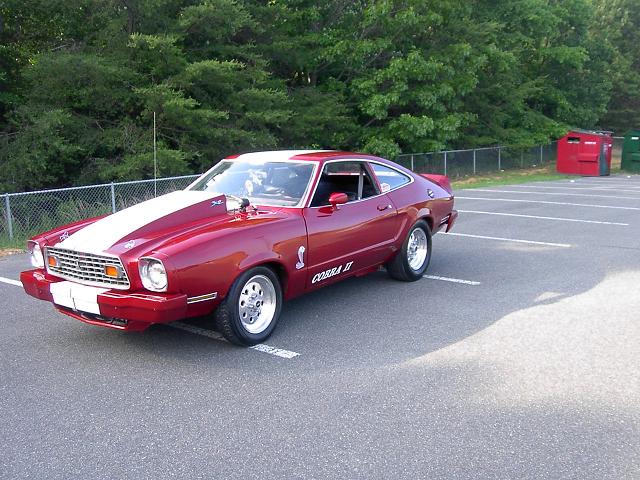1976 Ford Mustang COBRA II-American Muscle car
The Mustang was introduced at the 1965 New York World's Fair, Mustang Mania instantly swept the country, and a new automotive market segment was created - the 2+2 or better known as the 'ponycar.' Though its mechanical underpinnings descended from the Falcon, the Mustang was completely different. It was a compact, tight, clean package weighing in at a modest 2,550 pounds - a departure from the ever-enlarging American cars of the day. The classic long-hood short-rear-deck combined with a forward-leaning grille, elegant blade bumpers, sculptured body sides, fully exposed wheel openings and restrained use of bright trim gave the car a unique look that belied its affordability. Its looks were backed up with power, providing three optional V8 engines with up to 271 horsepower. Other options included automatic transmission, power steering and brakes, styled chrome wheels and air conditioning. Not surprisingly, the entry-level modes were a minority of the production.
1976 Ford Mustang COBRA II sports car
To say that the first Mustang was a success is an understatement. Following the introduction, the Mustang was on the cover of both Time and Newsweek. A week before introduction, Ford ran ads with the air times for the first television commercials, which all three networks broadcasted simultaneously. Mustang was selected as the Official Pace Car for the 1964 Indianapolis 500, and more than 22,000 orders were taken the first day. By its first anniversary, over 418,000 Mustangs had been sold, breaking the all-time record for first year sales of a new nameplate.
The original platform was used, with numerous modifications, up to 1973. The Pinto-based Mustang II was built from 1974 until 1978. A new fox body platform began in 1979 and was largely unchanged through 1993. In 1994 the SN-95, a modified version of the Fox body, debuted and was produced until 2004. The 2005 Mustang is built on the first entirely new platform in 25 years.
1976 Ford Mustang COBRA II Racing car
On the track, the Mustang name was quickly establishing itself in many motorsports arenas. In 1965, Mustang assumed the role as Ford's rally car. Carroll Shelby, famed builder of the Cobra, created race-ready cars for SCCA's production class B competition against the likes of Chevrolet's Corvette and the Jaguar E-Type. Shelby's goal was accomplished when the GT 350 took the B-Production Championship from Corvette. Shelby Mustangs were also successful in the world of drag racing. Ford campaigned several highly modified A/FX altered Mustangs equipped with 427 'Cammer' motors in National Hot Rod Association drag racing events. 1966 brought the creation of the SCCA Trans Am professional racing series for V-8 sedans of 305 cubic inches or less. Mustang took the Trans Am Manufacturers' Cup in 1966. The Shelby GT 350 repeated the previous year's success as B-Production Champion.
With the introduction of Chevy's Camaro, Pontiac's Firebird, and Ford's sister division 2+2, the Mercury Cougar, the rest of the industry both brought serious competition to the Mustang and further legitimized the 2+2 'ponycar' market. Ford foresaw the coming competition, and designed the 1967 Mustang to accommodate its 390 cubic-inch V8. In addition to the mechanical changes, the Mustang was restyled inside and out. This began the era of the growing Mustang, as it gained a couple inches in length and width nearly every year until 1973. A GT 350 H was introduced, a special edition made specifically for Hertz Rent-A-Car outlets. Stories of 'Rent-A-Racers' being returned with telltale signs of racing use are still told today. The options list grew as well, andFord's largest engine quickly went from the 390 to the 428 Cobra Jet. Shelby also upped the ante with the GT 500 in 1967 and the GT 500 KR ('King of the Road') in 1968. The GT 350 also continued on. In racing, despite new competition from the Camaro, Plymouth Barracuda, and Mercury Cougar, Mustang again won the Trans Am Manufacturers' Cup. Capping the year, Shelby's GT 350 once again took the SCCA B-Production crown. Perhaps the most famous Mustang of the time was the 1968 Highland Green 390 Mustang fastback driven by Steve McQueen in the movie Bullitt. Many still consider the final chase scene to be the best ever filmed.



